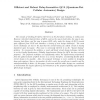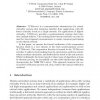33 search results - page 3 / 7 » Abstraction of Clocks in Synchronous Data-Flow Systems |
DFT
2006
IEEE
13 years 11 months ago
2006
IEEE
The concept of clocking for QCA, referred to as the four-phase clocking, is widely used. However, inherited characteristics of QCA, such as the way to hold state, the way to synch...
FMICS
2010
Springer
13 years 8 months ago
2010
Springer
Abstract. TTEthernet is a communication infrastructure for mixedcriticality systems that integrates dataflow from applications with different criticality levels on a single network...
ICCS
2004
Springer
14 years 28 days ago
2004
Springer
Abstract. We describe, analyze and submit results of a real-time total order multicast protocol developed on a distributed real-time system architecture that consists of hierarchic...
CC
2009
Springer
14 years 8 months ago
2009
Springer
Abstract. Clocks are a mechanism for providing synchronization barriers in concurrent programming languages. They are usually implemented using primitive communication mechanisms a...
ISLPED
2010
ACM
13 years 5 months ago
2010
ACM
Abstract--As a replacement for the fast-fading GloballySynchronous model, we have defined a flexible design style called GRLS, for Globally-Ratiochronous, Locally-Synchronous, whic...


